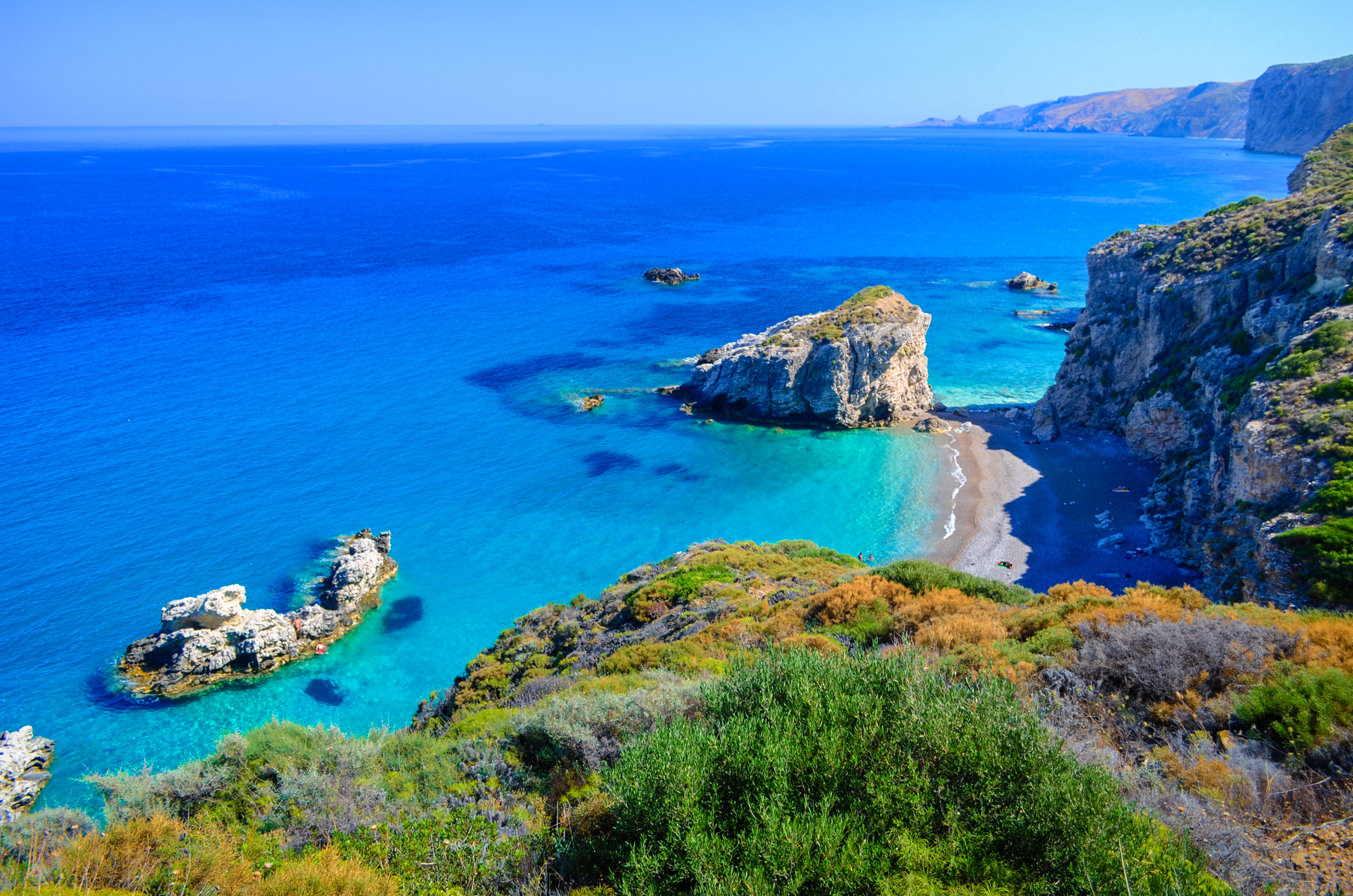Island Hopping Greek Islands: A Private Boat Guide

Published on: March 21, 2024
By PANOS BARDIS, Owner & Ceo of SEAZE THE DAY
“This post is currently in the works. We’re putting together all the insider tips and must-know details for your perfect island adventure. Please check back soon for the complete guide!”
Greece, with its treasure trove of over 6,000 islands, 227 of which are inhabited, mixes rich history with perfect summer escapes. Now, imagine yourself sailing Greece’s gems in a private boat, steering clear of crowded tourist spots. This experience embodies Island Hopping in the Greek Islands.
In this guide, we’ll dive into how to organize your island-hopping trip. Moreover, we’ll suggest top itineraries and offer tips on the best times and how long to stay. Whether the allure of famous islands or the secluded charm of hidden gems draws you, choosing to explore by private boat opens a world of endless possibilities.
So, let’s embark on planning together an unforgettable adventure of Island Hopping in the Greek Islands!

Why Choose a Private Boat for Island Hopping
Greece is the perfect place for a special kind of adventure—exploring its islands by private boat. Imagine sailing between islands that are close together but each have their own unique charm.
Greek islands are split into four main groups: the Cyclades, the Dodecanese, the Sporades, and the Ionian Islands. Each group has famous islands everyone knows about and secret spots waiting to be discovered. And don’t forget about Crete, the biggest island of them all.
Here’s why picking a private boat for your trip is a really smart move:
Make Your Own Schedule
With a private boat, you’re the boss. You decide where to go and when. If you wake up wanting to change plans because of the weather or just because you feel like it, you can. This freedom lets you enjoy your trip exactly how you like.
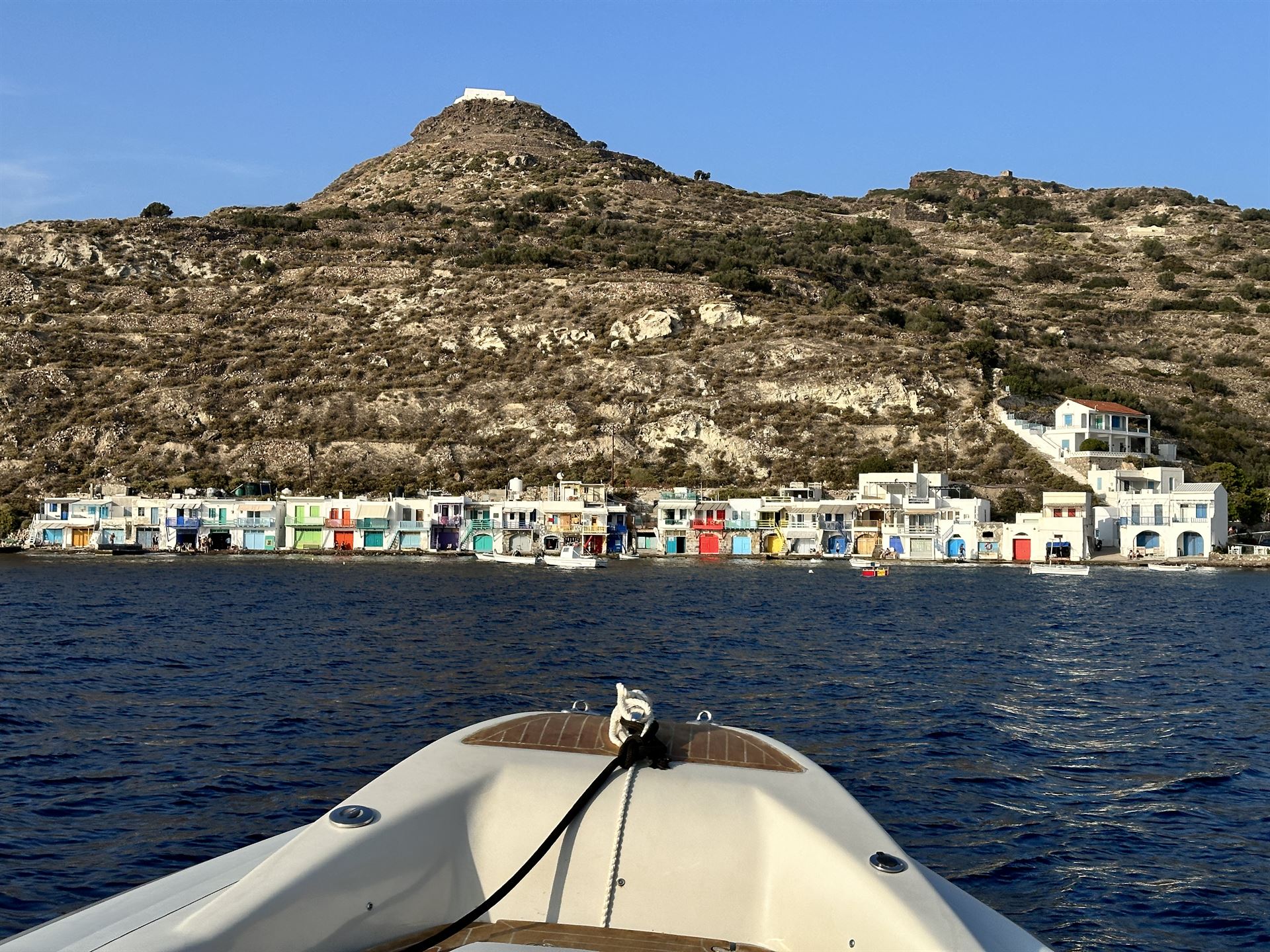
Your Own Private Space
On a private boat, you don’t have to share your space with strangers. This means you can find quiet beaches, small hidden coves, and even spend the night in magical places most people never see. You can have meals on the boat and really feel the sea around you, making your trip truly your own.
Value for Money in Every Wave
While the idea of chartering a private boat for island hopping might initially seem lavish and out of reach, it’s actually a smart, cost-effective choice that offers unparalleled experiences. Whether you’re eyeing a nimble RIB or envisioning yourself aboard a majestic yacht, there’s an option tailored to fit your budget. The real savings come into play when you consider bypassing the costs and hassles of ferries, taxis, and hotel stays.
Moreover, the freedom to explore hidden coves and dive into azure waters at your leisure isn’t just a luxury; it’s a transformative experience. When you weigh the time saved from avoiding the logistical challenges of traditional ferry and plane travel, combined with the ability to visit more islands and secluded spots, the value transcends mere cost. It’s about enriching your holiday with unforgettable memories and experiences that are worth every penny.
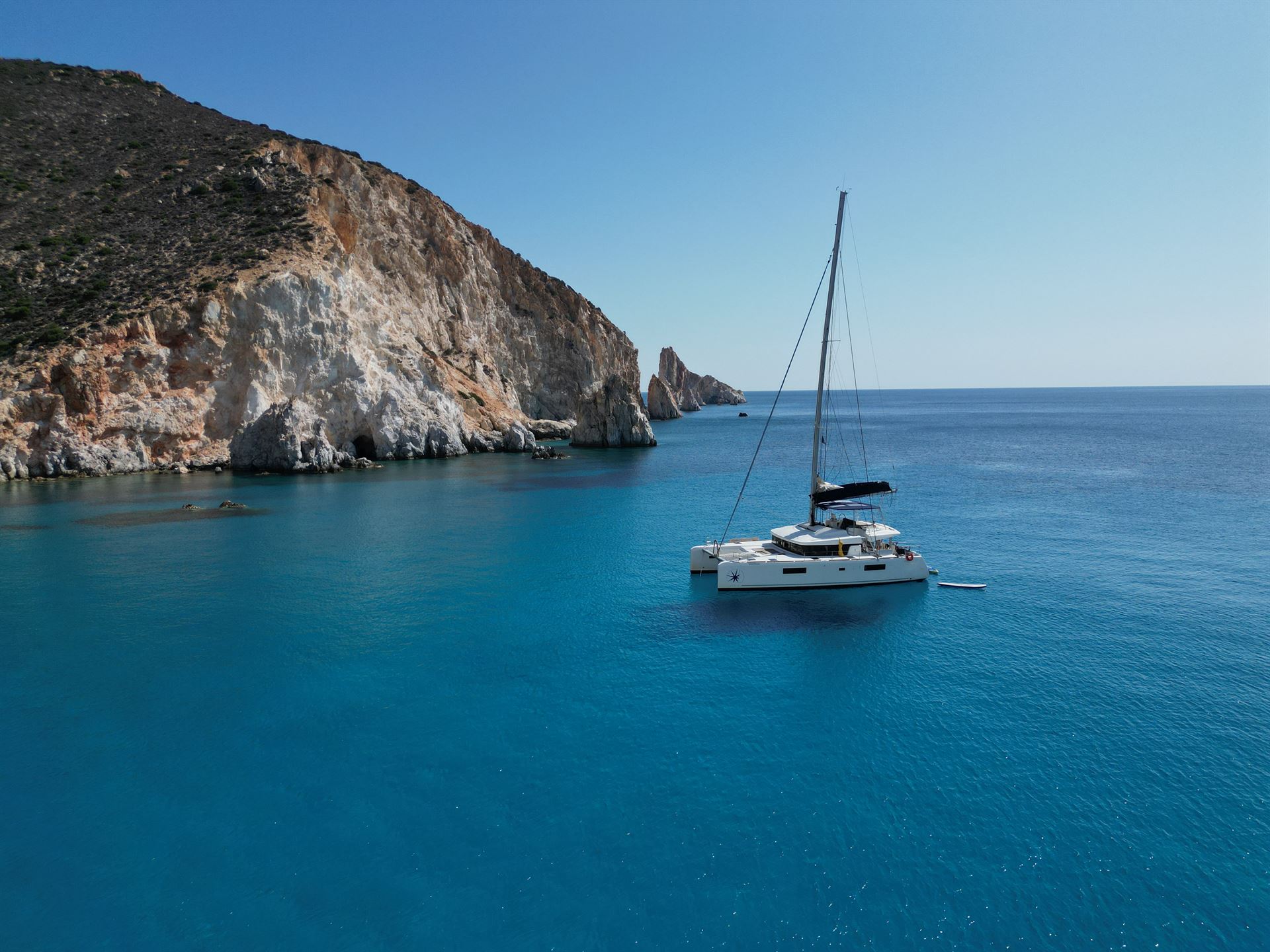
How to organize your Greek Island Hopping tour
You’re probably at home, tired after a day’s work, trying to unwind in bed. Your mind wanders to organizing your summer vacation in the Greek Islands, and you find yourself surfing the net, seeking answers to a whirlwind of questions: How? Where? When? Which islands should you explore? It’s a common scenario for many embarking on this planning journey.
This section is designed to ease that process for you. We’ll cut through the clutter and focus on the most important aspects, answering the common questions that arise as you plan your Greek Island hopping adventure. So, let’s dive in together and discover the essential tips that will make your island-hopping journey unforgettable!

Deciding When to Go: Picking the Perfect Season
When planning an island-hopping adventure in the Greek Islands aboard a private boat, choosing the right season is arguably the most crucial decision you’ll make. The season affects everything from the weather to the crowds and can dramatically alter your experience. The window for island hopping stretches from early April through the waning days of November, with the peak season nestled between July and August. To give you a clearer picture, let’s break down the pros and cons across three distinct travel periods:
Spring Traveling (April to June 10)
Spring travel, running from April to June 10, beautifully blends the end of spring with the start of summer. This season usually brings calmer seas, offering a more peaceful experience. However, the weather can be a mix of sunny and rainy days, as if nature is slowly transitioning to summer.
During this period, sea temperatures are cool at first, around 17-18 degrees Celsius, perfect for quick dips. By the start of June, the water gets warmer, reaching 20-21 degrees, inviting for longer swims. The air temperature during the day varies from a pleasant 18 to 28 degrees, but nights can cool down to between 13 and 19 degrees. This means you’ll need to pack both warm clothes for the evenings and lightweight options for daytime adventures. Don’t forget an anorak for sailing, and a wetsuit could be a great addition for those who love snorkeling or spearfishing.
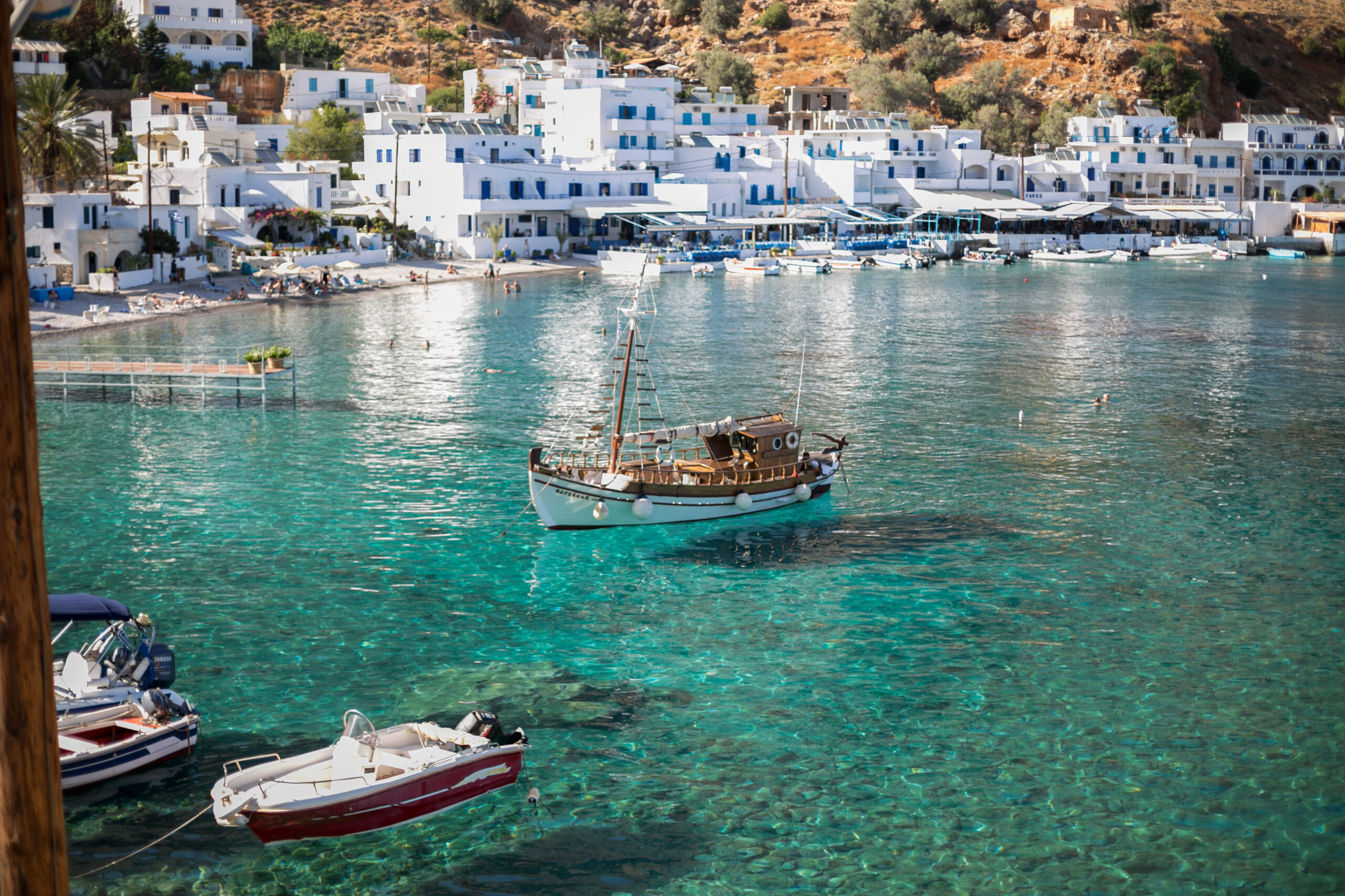
One of the best parts about this season is the ease of finding accommodations and enjoying popular beaches without the crowds. Marinas are also less crowded, making docking simpler. However, it’s worth mentioning that some beachside venues, especially on the smaller islands, might not be open yet.
Spring island hopping the Greek islands not only promises gentler seas and a mix of weather patterns but also showcases the islands’ lush landscapes. It’s the greenest time of the year, perfect for those who enjoy trekking and hiking. The cooler temperatures make exploring the islands’ trails and discovering their natural beauty an absolute delight. Plus, visiting well-known islands like Mykonos, Santorini, and Milos during this time means you’ll get to experience their famous charm with fewer tourists around.

Summer Traveling (June 10 through the end of August)
Traveling to Greece during the summer, from June 10 to the end of August, is a popular choice, thanks to the warm weather and inviting sea. This period marks the peak of summer, with the busiest days spanning from July 20 to August 16, coinciding with the time many locals head to the islands for their vacations. During the day, air temperatures can range from 30 to 40 degrees Celsius on the hottest and sunniest days, and at night, they vary between 20 and 28 degrees.
June usually has calm weather, but July and August bring the Meltemia winds to the Cyclades Islands. These strong northwest winds, hitting 4 to 7 on the Beaufort scale, peak around noon and calm by evening. It’s important for those planning to sail around the Greek islands to keep this in mind for a smooth journey.

Summer attracts partygoers and beach bar fans. Yet, those seeking peace can find serene moments on less crowded islands, particularly if they avoid popular ones. An insider tip: the Ionian Islands often have calmer seas.
For a memorable island-hopping adventure, it’s wise to arrange everything 3-5 months ahead. This includes selecting a boat and planning your itinerary. Or, you can let a trusted company manage everything, so you can simply look forward to your Greek island getaway.

Autumn Traveling (September through 20 of November)
The prime season for boat lovers and those seeking serenity. Autumn in the Greek islands offers calm seas, pleasant temperatures, and less crowded spaces. It’s my personal favorite time of year! The sea is surprisingly warmer than in summer. Daytime air temperatures range from 25-30°C, while nights are cooler, between 14-20°C.
What to Pack: For your autumn adventure, bring trekking or hiking shoes to explore the islands’ landscapes comfortably. Don’t forget a hat and sunscreen, as you would in summer, alongside light clothes. However, be prepared with warmer garments and protection against wind and rain, as showers can occur.

This period is perfect for visiting the famous islands. Everything becomes easier – finding boats for rent, securing accommodations, and dining out. Plus, with fewer tourists, you get to experience the islands more authentically.
The sweet spot? From September 15 to mid-October. That’s when the magic really happens. If you’re dreaming of island hopping around the Greek isles, don’t let this incredible season pass you by. Consider setting aside at least 10-15 days for exploration. Trust me, it’s a must in Greece.
Eager to learn more about island hopping in Greece? Excited to discover top itineraries? Keep reading. We’re about to dive deeper into an adventure that awaits!

Choosing the Right Boat for your Greek Island Hopping Adventure
Choosing the ideal boat for your multi-day private tour through the Greek Islands is crucial. The perfect choice hinges on various factors. Firstly, consider your budget and the type of vacation you envision—be it luxurious or adventurous? Secondly, think about the islands you plan to visit. The distance between them, the size of your group, and whether you intend to spend nights aboard are all important.
Furthermore, reflect on the number of days you have for your adventure. Your preference for leisurely cruising versus quick transit between locations will also influence your decision.
In this section, we delve into each boat category—yachts, cabin motorboats, sailing boats, and adventurous RIBs (Rigid Inflatable Boats). We’ll explore the advantages and drawbacks of each, assisting you in making an informed decision.
YACHTS: Luxury at Sea
Island hopping in the Greek Islands via yacht is undoubtedly a premium choice, one that comes with a significant price tag. Charter fees for these luxurious vessels start from €1,500 daily, potentially escalating to €50,000, based on the yacht’s size, amenities, crew, and fuel costs. Defined as luxury motorboats exceeding 14 meters, yachts feature well-appointed cabins, bathrooms, kitchens, and additional sea toys like jet skis and tenders. Some extend over 50 meters, offering multiple rooms perfect for overnight stays.

Given this, budget becomes a primary consideration. Yet, for those who can afford such splendor, the possibilities are boundless. The true luxury of yacht chartering lies in its privacy and the comprehensive service provided. The crew ensures a seamless experience, managing navigation, meals, and shore transfers with tenders. Whether you wish to sleep under the stars or dock in renowned marinas, every need is met.
Moreover, onboard dining is a highlight, with a chef ready to cater to your culinary preferences. Available for short trips or extended voyages, yachting offers an unmatched blend of freedom, privacy, and indulgence. That makes it an ideal way to explore the Greek islands’ beauty in style.

SAILING BOATS: Harnessing the Wind
Sailing boats are indeed the most popular option for navigating the Greek islands. These versatile vessels sail with the wind or utilize an inboard engine, cruising at an average pace of 7-8 knots. Consequently, they are perfect for travelers who are not in a rush and wish to savor their time at sea.
Additionally, these boats can be chartered with a skipper and crew. For those with sailing experience, opting for a “bareboat” rental is also possible. Notably, sailing boats are renowned for their safety, making them a favorite among international visitors who often bring their own 10-13 meter vessels.

Furthermore, the capacity and amenities of these boats largely depend on their size. An average sailing boat, measuring between 33-45ft (10-14m), typically features a welcoming deck, a small saloon with sleeping arrangements, a kitchen, and 2-3 cabins with double beds. This setup comfortably accommodates at least 6 persons, with larger models offering more space.
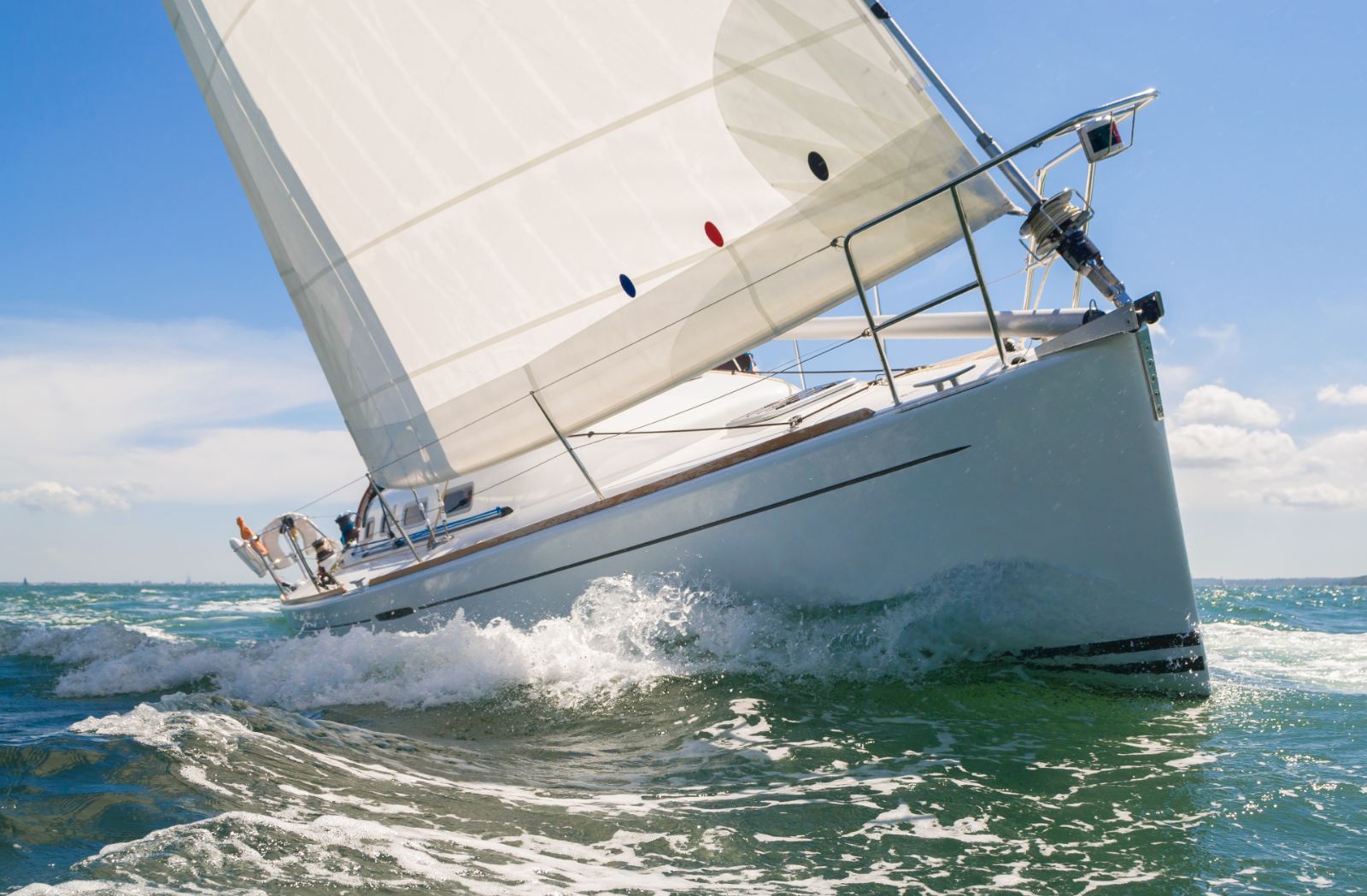
Economical Island Exploration – Cost Comparison
Opting for a sailing boat is a cost-effective way to explore. It eliminates the need for hotel accommodations, car rentals, and dining out. To illustrate, let’s break down the costs. If six friends share a boat, with an average daily rate of €400, plus €200 for cleaning fees per booking and €20 daily for fuel, a 10-day island-hopping trip in Greece totals €4,400. Divided among six passengers, the cost is approximately €733 per person, or €73.3 per day.
Indeed, consider the expenses of ferry travel, car rentals, hotel stays, and restaurant meals. Sailing emerges as an economical and unique adventure compared to traditional travel methods.
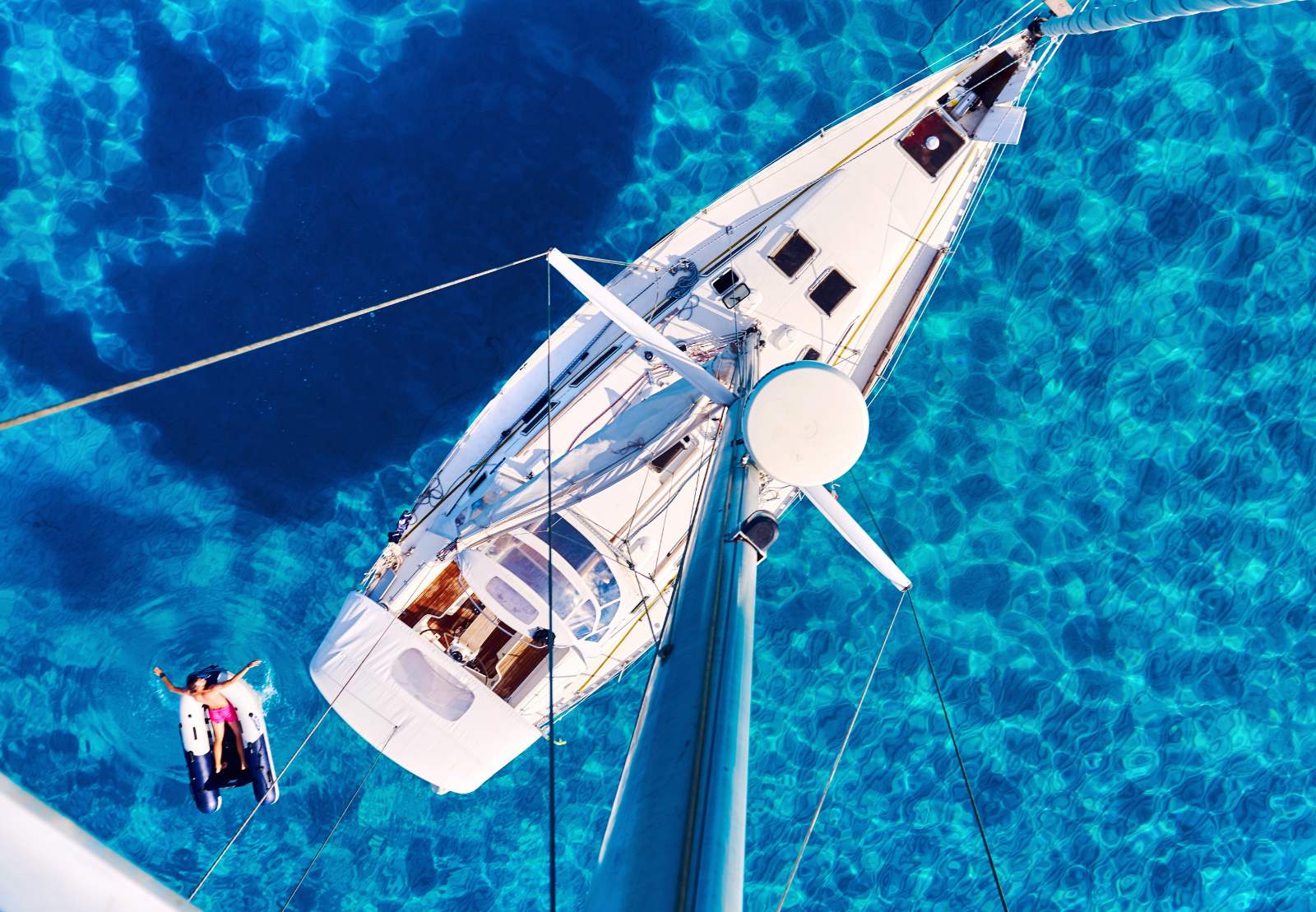
Pace of Travel
Moreover, it’s important to remember that sailing offers a leisurely pace. It’s an ideal choice for those with the luxury of time, wanting to enjoy every moment of their journey.
Now, let’s explore additional private boat options for island hopping in Greece!
CABIN MOTORBOATS: Speed and Flexibility
When it comes to island hopping in Greece, cabin motorboats are a fantastic choice. These vessels, typically 10-12 meters in length, are often powered by twin engines. This feature is crucial for both efficient cruising and safety. If one engine fails, you still have a backup to continue your journey at speeds of 10 to 15 knots.

Mostly, these boats boast a main cabin with a double bed, a toilet, and sometimes, a secondary cabin at the back with two single beds. This setup comfortably accommodates 3-4 travelers for overnight stays. Plus, there’s ample space to keep your luggage dry – a must when you’re at sea!
Furthermore, cabin motorboats are well-equipped for a comfortable journey. You’ll find fridges (including ice fridges), fresh water, and cooking facilities with gas or induction hobs. On average, they consume 3-4 liters of gas per nautical mile and are mostly available for rent with a skipper in Greece.

Indeed, what’s better than having an experienced local captain and crew? They ensure safe and efficient travel, all while offering insider tips on the best spots to visit, dine, and swim.
With room for up to 6-7 passengers plus the captain and crew, larger groups have the option to stay overnight in hotels or villas. This can be ideal, allowing you time to rest onshore and explore each island’s mainland too.

In summary, cabin motorboats are perfect for those seeking speed, flexibility, and the thrill of discovering multiple islands.
RIBS: The Adventurous Choice
RIBs (rigid inflatable boats) are not just boats; they’re a trend that has captivated Greek boaters for over 20 years. Renowned for their flexibility, low fuel consumption, and ample space, RIBs are the go-to for those seeking adventure across the Greek islands. Their open decks provide freedom and a unique connection to the sea, making every journey unforgettable.

Moreover, RIBs have earned their stripes in safety and reliability, used by marines, coastguards, and for rescue missions. For family outings, RIBs measuring 6-8 meters in length are typical. Yet, for island hopping, the preferred choice stretches between 9-11 meters. Recently, the market has welcomed even larger ‘super RIBs’ of up to 14 meters, elevating the experience with additional comfort and amenities.
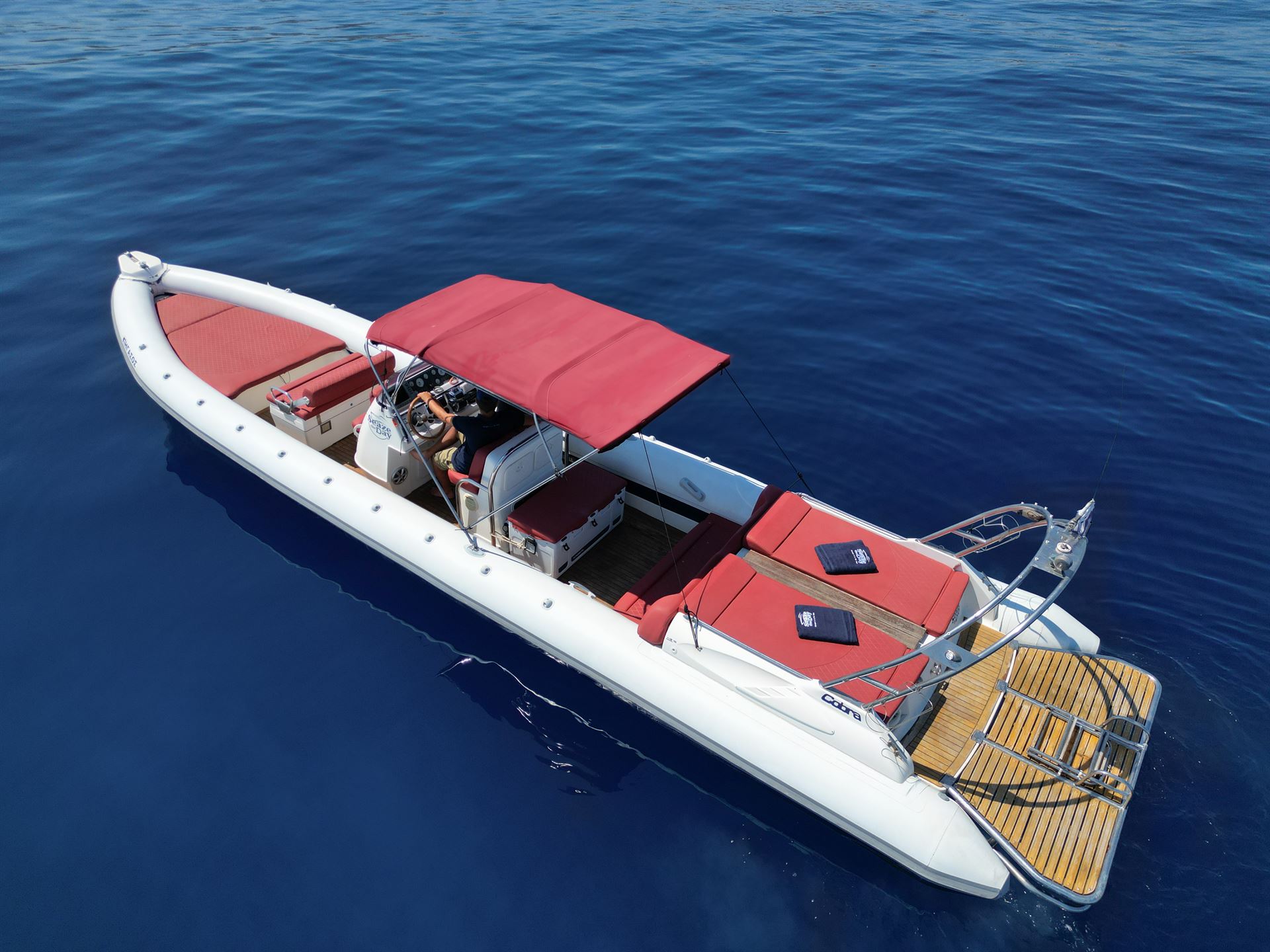
The majority of RIBs boast an open deck design, with some featuring cabins and toilets, ensuring comfort alongside adventure. Traveling by RIB offers a truly remarkable experience—imagine feeling completely free, surrounded by the ocean in every direction.
Here at Seaze the Day, we specialize in turning your Greek island hopping dreams into reality with RIBs. Whether it’s crafting unique itineraries, organizing overnight stays in hidden coves, discovering great fishing spots, or snorkeling in crystal clear waters, we’ve got it all planned. Our experienced team is dedicated to designing your trip with flexibility, tailored to meet your unique needs and desires.

Join us to explore the Greek islands like never before. With Seaze the Day and our trusted RIBs, you’re set for an adventure that adds a whole new dimension to island hopping.
Where to Island Hop in Greece
The Greek Archipelagos are part of the Mediterranean Sea (Mesogios). We can divide the Greek sea into different parts, including the Aegean Sea and the Ionian Sea.

The Aegean Sea (Aigaio Pelagos) stretches between the western part of the Greek mainland and the eastern coasts of Turkey, reaching southward to Crete and Rhodes, while connecting to the Marmara Sea in the north. It’s further divided into smaller sections like the Thracian Sea, Mirtoo Sea, and Ikarion Sea, each with its own group of islands.
Consequently, the Aegean Islands can be categorized into several sections: the Dodecanese, Cyclades, Sporades, the islands of the Saronic Gulf, and the North Aegean Islands.

Additionally, there’s the Ionian Sea (Ionio Pelagos), extending from the western coasts of the Greek mainland to the eastern part, reaching to the eastern coasts of Italy in the west. It’s bordered by the Adriatic Sea to the north and extends to Malta and Crete in the south. In the Ionian Sea, you’ll find the Eptanisa, also known as the Ionian Islands, along with some other smaller islands.
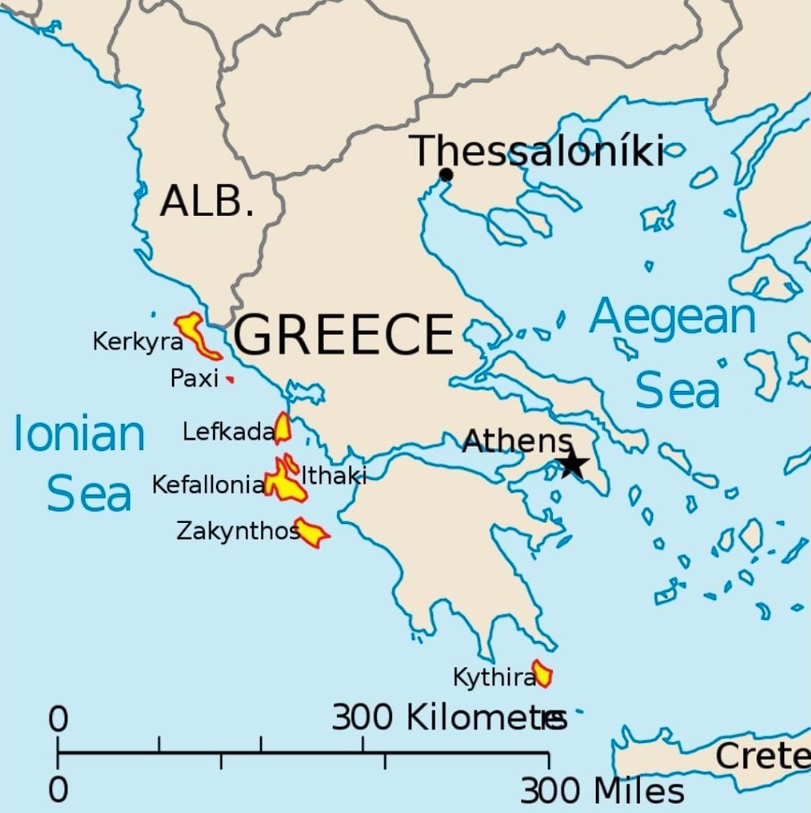
Besides these islands, you will find some other separate islands like Crete, the southernmost and largest island-section of Greece, and Evia, located to the east of the prefecture of Attica (the second-largest island of Greece). Additionally, there are Kythira and Antikythera, situated between Crete and the southern coast of the Peloponnese.
With over a thousand islands in Greece, island hopping enthusiasts have a plethora of options to explore! However, they must focus their interest on a specific section due to the considerable distances between them.
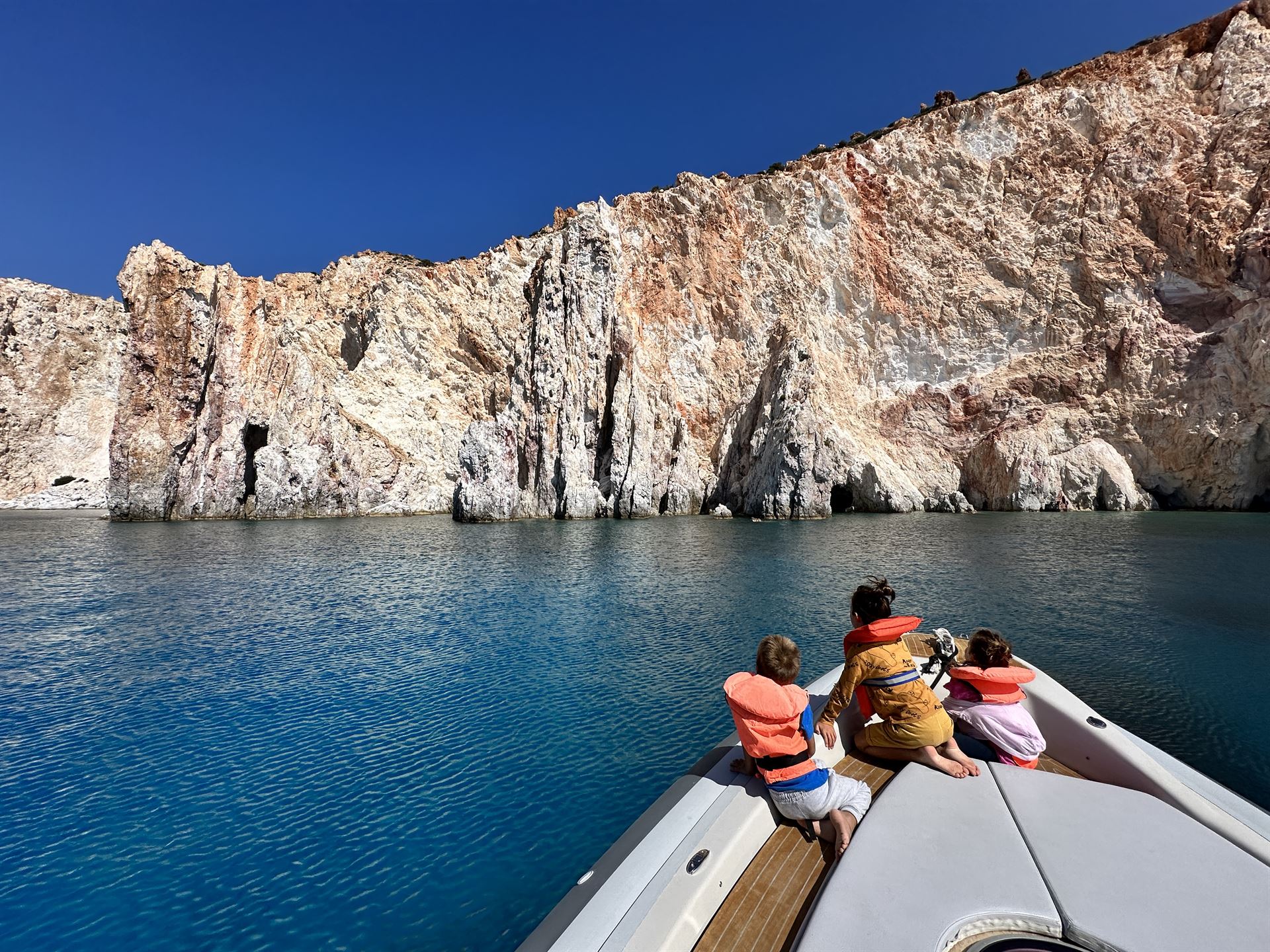
Selecting the Ideal Island Group for Your Greek Island Hopping Adventure
Next, we’ll explore each Greek island group, highlighting the included islands, their locations, and essential tips for your journey. This guide will assist you in choosing the best starting point and ideal season, among other insights, for your private boat adventure. Ready to discover your perfect island group? Let’s get started.
IONIAN ISLANDS (Eptanisa)
The Ionian Islands, known as “Eptanisa” in Greek (seven islands), are a group of islands in the Ionian Sea, off the west coast of Greece. These islands include Corfu (Kerkyra), Kefalonia, Zakynthos (Zante), Lefkada, Ithaca (Ithaki), Paxi (Paxos), and Kythira*. Each island offers its unique blend of stunning landscapes, crystal-clear waters, and rich historical sites, making the Ionian Islands a favored destination for those seeking both relaxation and cultural exploration.
In addition to these seven main islands, the Ionian Islands region includes several smaller islands and islets that are also worth mentioning, such as Antipaxos, near Paxos, which is famed for its vineyards and stunning beaches like Voutoumi; and the Diapontia Islands, including Othonoi, Ereikoussa, and Mathraki, situated northwest of Corfu and known for their serene beauty and traditional lifestyle.
*While Kythira is part of the Ionian Islands, its location makes it a perfect stop between the southern mainland of Greece and Crete due to its significant distance from the other Ionian Islands.

GETTING TO THE IONIAN ISLANDS
Traveling to the Ionian Islands is a straightforward affair with multiple options to suit any preference:
- Direct Flights: There are direct flights available to the airports of Kefalonia, Zakynthos, and Corfu, providing immediate access to these beautiful destinations.
- Via Athens: For those unable to find direct flights, an alternative route involves flying to Athens and then catching a connecting flight to the islands. This option allows for a brief exploration of the capital before continuing to the islands.
- Ferries from Patra: A scenic and accessible option involves taking a ferry from the port of Patra, which is a 2.5-hour drive from Athens. The ferry ride to Corfu, the northernmost of the Ionian Islands, takes approximately 7.5 hours. This option offers a unique opportunity to experience the journey by sea.
- Drive to Lefkada: Uniquely, Lefkada can be reached by car thanks to a sea bridge connecting it to the mainland. This makes Lefkada an excellent starting point for an island-hopping adventure.
- Preveza Airport: Flying into the airport of Preveza, which is close to Lefkada, offers the possibility to rent a private boat.
Useful Links for Traveling to the Ionian Islands*
By Air
skyscanner(flights to Ionian Airports and Preveza)
By Sea
ferryscanner(ferries from Patra to Ionian Islands)
By Land
athens taxis (taxis from Athens international airport to Patra & other airports, ports, adresses)
Hellenic Train Site (train tickets from Athens to Patra)
*The links provided are valid as of April 2024
SARONIC GULF ISLANDS
